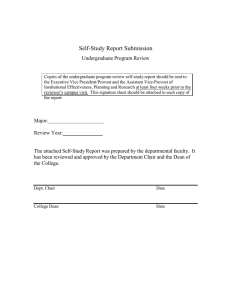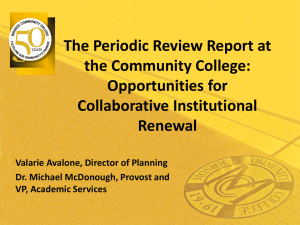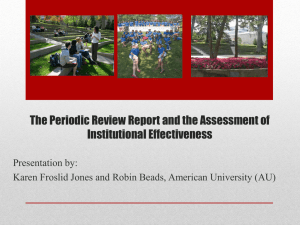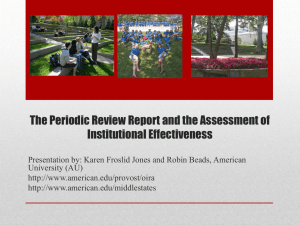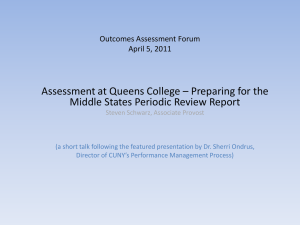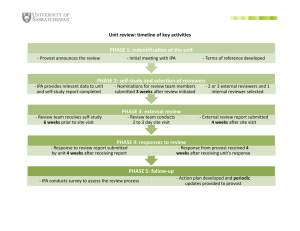Faculty, Administration, Trustees, and Students of American University
advertisement
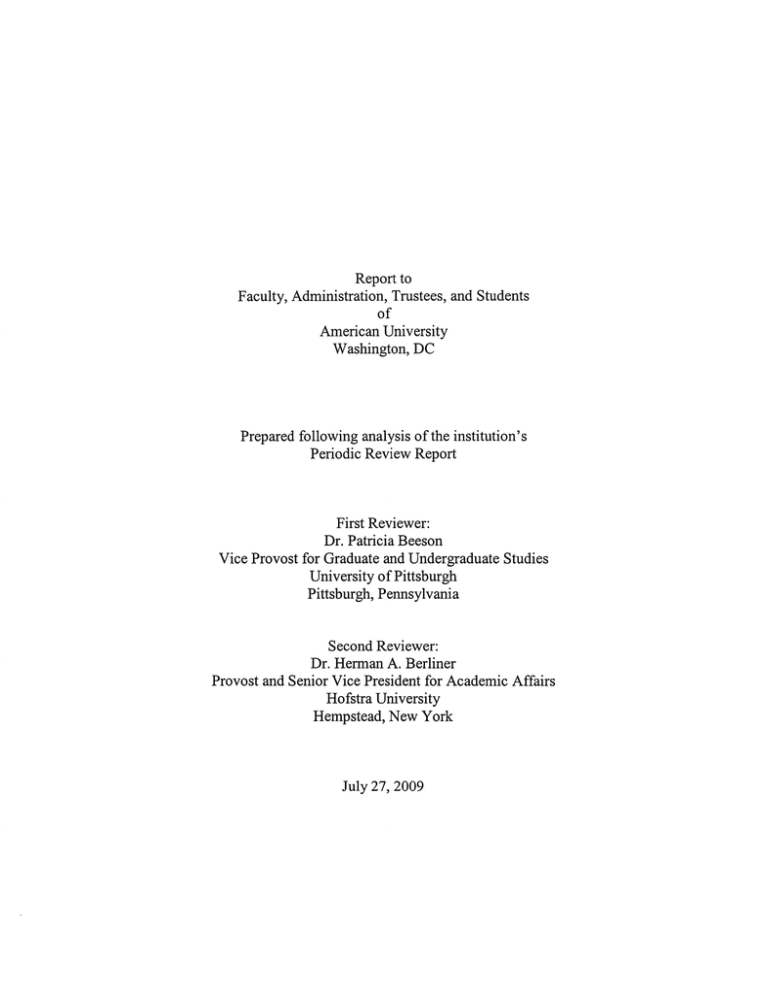
Report to Faculty, Administration, Trustees, and Students of American University Washington, DC Prepared following analysis of the institution's Periodic Review Report First Reviewer: Dr. Patricia Beeson Vice Provost for Graduate and Undergraduate Studies University of Pittsburgh Pittsburgh, Pennsylvania Second Reviewer: Dr. Herman A. Berliner Provost and Senior Vice President for Academic Affairs Hofstra University Hempstead, New York July 27, 2009 I. Introduction The American University PRR is well-organized and provides sufficient evidence to support the conclusion that the University meets the accreditation standards of the Middle States Commission. The PRR addresses the challenges identified in the 2004 self-study and evaluation team report, reviews areas of institutional achievement, identifies current issues and challenges, describes approaches taken to assessment, and addresses the relationship between institutional planning and budgeting. In addition, the PRR documents a new leadership committed to openness and inclusion, a new strategic plan, a commitment for academic excellence, and sound financial underpinnings. When taken together, the PRR presents a university that is on solid ground and making progress towards its established goals. The PRR was prepared and reviewed in a systematic manner, drawing from the appropriate existing committees for content. The process was led by the Coordinating Committee, a re-constituted version of the 2004 Self-Study Steering Committee with a few members added to replace individuals who have left the University. Major sections were drafted by existing committees: Section 3: Major Challenges and Opportunities is based on work of the Strategic Planning Committee; Section 4: Enrollments and Financial Trends and Projections is based on work of the Budget Committee; Section 5: Assessment ofLearning Outcomes is based on work of the Learning Outcomes and Assessment Team; and Section 6: Institutional Planning and Budgeting Processes is based on work of both the Budget and Strategic Planning Committees. We commend the University for the extent to which the accreditation process has been integrated into the normal processes of the University. American University (AU), a private, doctoral-research university located in the nation's capital, offers undergraduate, graduate, and professional degree programs. It enrolls approximately 12,000 students about half of whom are enrolled in undergraduate programs. Interdisciplinary inquiry, international understanding, interactive teaching, research and creative endeavors, and practical application of knowledge are at the heart of its mission. There was a major change in leadership in 2005, when then-President Benjamin Ladner was placed on administrative leave and then-Provost Kerwin was named acting president. In October 2005, the Board removed Ladner as president following an investigation into personal and travel expense. Kerwin became President following a national search. Under Kerwin's leadership, communication between the university's leadership and its various constituencies has become more open, members of the University community appear to be more engaged in decision making, and the University has set a direction for the coming years in an appropriately aggressive strategic plan, enacted in 2008, that is advancing the University's mission. Accompanying these changes is the further development of a culture of assessment that supports the assessment of institutional effectiveness and student learning at all levels. II. Summary of Responses to Recommendations This section summarizes AU's responses the recommendations made in the 2004 report of the Middle States Evaluation Team along with those contained in the Self-Study. The Evaluation Team report contained recommendations related to program review and assessment of student learning in both the graduate and undergraduate programs. The Self-Study contained recommendations related to Communication, Resources, Academic Programs and Faculty, and Engagement. Visiting Team Recommendation One: That apian be developed and implementedfor internal and external evaluation ofall undergraduate and graduate programs. The PRR reports that the University has instituted a systematic process of program review for all programs not subject to external accreditation. Program reviews under the new process began in 2008-09 when the first three departments were reviewed. In subsequent years, three departments are to be reviewed each year, leading to a seven year cycle of program review. As part of the program review departments must address: learning outcomes assessment, the relationship between the department and University mission, contributions to general education, and retention. In general, the program reviews are data driven and outcomes oriented, and designed to provide evidence in accordance with specific aspects of Middle States' Characteristics ofExcellence. Visiting Team Recommendation Two: That the Learning Outcomes and Assessment Team intensify its efforts to oversee the completion and implementation ofStudent Learning Outcomes Assessment Plan for all undergraduate programs — including General Education as well as those accredited by external agencies. (There is a parallel recommendation for graduate programs). The 2004 Self-Study and Evaluation Team Report agreed that while AU had begun to place more emphasis on outcomes assessment, more progress was needed. AU now has in place a process through which learning outcomes are assessed and the PRR projects an institution with a very well-developed culture of assessment. The PRR contains a comprehensive overview of the learning outcomes assessment process that has been instituted at AU in response to this recommendation. We respond more fully to this in Section V of this report. The PRR reports that faculty now have a better understanding of assessment and the process is valued; assessment plans are more meaningful; expected learning outcomes are communicated; there is a clearly defined process for reviewing plans; and there is clear evidence of curricular improvement as a result of the assessment process. Self-Study Recommendation: Communication The Self-Study included, and the evaluation team endorsed, recommendations that the institution more effectively communicate progress toward institutional goals as articulated in the mission statement and strategic plan. As discussed throughout the PRR, one of the key changes that resulted from the transition of leadership at AU is more open communication between the University's leadership and the various university constituencies. The PRR description of the Strategic Planning process and the drafting of the PRR are clear and strong examples of processes with appropriate participation of faculty, staff, and students. Stronger communication is also evident in the regular presidential updates to the university community, open forums held by the president and chair of the board, and increased participation of members of the university community in the activities of the board. Improvement in internal communications is also evident in the high level of interaction between the provost and the faculty including the provost meeting individually with 159 faculty members and over 46 departments during the past year. The PRR also documents changes in the Board of Trustee practices and policies that have lead to more open communications with the university community. Following the departure of the President Ladner, the AU Board of Trustees conducted an open review of its fiduciary practices involving a comprehensive review of best practices at other institutions and the services of outside consultants. This assessment resulted in significant changes to Board practices, such as expanding Board membership to include two members of the faculty, one student, and one recent graduate, and more regular and open communication with members of the university community. We commend AU leadership for the steps it has taken to rebuild the trust and confidence of the university community following the departure of the past president by through openness and the engagement of members of the university community in the governance process. Self-Study Recommendations: Space and Financial Resources The Self-Study contained several recommendations related to resources and resource allocation, specifically resources needed for the library, graduate student support, and undergraduate student life. In response, the PRR reports that the institution has updated and expanded the library space resulting in a 50% increase in public seating, found new space on campus for the library's print collection by moving more of the print journal collection offsite, and increased the library's acquisition budget by over one million dollars. AU has conducted a review of the graduate financial aid budget and administration, as recommended in the SelfStudy and endorsed by the visiting committee, and as a result of this review, the financial aid packages being offered to incoming students are more competitive. The PRR also reports that all three student life facilities mentioned in the Self-Study as in need of upgrading have been renovated. Based on the PRR report, we conclude that the institution has addressed the resourcerelated recommendations contained in the Self-Study. Self-Study Recommendation: Academic Programs and Faculty The Self-Study contained several recommendations related to academic programs and faculty. The Evaluation Team supported the recommendations of the Self-Study and agreed that careful study should be given to plans for future growth of university-wide general education requirements. At the time of the Self-Study, AU was considering expanding its general education requirements to include, for example, a language requirement, and the Self-Study cautioned that the University not "grow university-wide requirements" in a way that would reduce student flexibility in choosing to double major. Following the Self-Study, the University reviewed the proposed general education requirements and decided not to expand the requirements. The PRR reports that the General Education Program continues to play a vital role in the undergraduate program, contributing to the recruitment of students, development of livinglearning communities, and the success of the University College, AU's living-learning program. The General Education Program is slated for a full review in 2009-10. In response to the Self-Study recommendation concerning the number and stature of graduate programs, the PRR reports that the new strategic plan invites units to propose new doctoral programs. The recommendation is also addressed through the new program evaluation process discussed earlier. The final resource-related recommendation in the Self-Study is that faculty teaching loads be reduced. The PRR reports that this has happened and that faculty workloads in general is the subject of a current campus-wide discussion being led by the provost. Self-Study Recommendation: Engagement A special focus of the 2004 Self-Study was engagement, a distinguishing aspect of AU, captured in the mission statement by the phrase "Ideas into Action, Action into Service". The PRR reports that the University has incorporated into its strategic plan the recommendation that AU assess engagement and related student learning outcomes and incorporate findings into all decision making and planning processes. Several of the goals of the strategic plan relate to engagement and call for increased documentation of student and faculty engagement, broadly defined. The University's plans to expand opportunities for academic engagement such as service learning and internships, as well as international engagement, already a strength of the undergraduate programs, will further the University's mission related to engagement. A key feature of AU's strategic plan is to take advantage of the institution's location in the nation's capital. The PRR notes that over the past few years the university has developed several strategic partnerships with government, business, community and cultural organizations that are designed to enrich the academic experience. These partnerships with the organizations such as the National Archives and various Smithsonian Museums will allow AU to develop opportunities for students to have meaningful internship experiences and for faculty to develop fruitful collaborations. III. Major Challenges and Opportunities The PRR identifies nine challenges and opportunities that will shape the development of the institution over the next five years. These emerged from the work of the Strategic Planning Steering Committee that included the review of a wide range of information from internal sources, including demographics, retention and graduation rates, faculty composition, etc., and external benchmarks drawn from a large variety of sources including national surveys, IPEDS reports, NSF, USNews rankings information, and the Common Data Sets. The results of this analysis were made available as part of the institution's strategic planning website. The PRR links each of the nine challenges and opportunities to related standards in the Middle States Characteristics of Excellence. The need to diversify its revenue stream was one of three overall recommendations of the 2004 Self-Study and this recommendation was affirmed by the visiting committee. The PRR notes that over 94% of the institutions budget traditionally comes from student fees. AU has identified two additional sources of funding, voluntary giving and sponsored research, and has developed plans to increase both. The success of the current capital campaign, which has raised $183 million of its $200 million goal (as of 5/29/09), is encouraging, as are plans to connect more alumni to the institution under the leadership of the new vice president for development and alumni relations. This institution is also positioning itself to increase sponsored research consistent with its aspiration to have a more research-oriented classification in the Carnegie system than its current classification as doctoral-research. The newly appointed provost, Dr. Scott Bass, brings with him experience as vice president for research and Dean of the Graduate School at UMBC, and has recently reorganized his office to include a similar position as part of a strategy to increase sponsored research. As part of the effort to increase the institution's research profile, AU plans to re-examine and more clearly define expectations for faculty scholarship and workloads and to reconsider its graduate offerings. The restructuring of the position of dean for academic affairs to be a vice provost for faculty who will oversee the expansion of the center for teaching excellence into a center for faculty development, may also provide support for the faculty as research expectations increase. The development of new centers at AU is intended to enhance the interdisciplinary nature of the university and increase sponsored research. The newly created Center on Latin American and Latino Studies engaging nearly 70 scholars from across the institution is a good first step in this direction. A final opportunity for AU as it moves forward is new Master Facilities Plan that the institution is developing and plans to complete in 2001. This Plan is intended to further the institution's Strategic Plan and is especially important since "AU lags behind its competition in providing students with the social and recreation space they would like." In defining all its opportunities for the future, AU has spelled out an "Enabling Goal" that appears to be a perfect fit for the university and a potentially transformative opportunity for an already strong institution. This goal is an outgrowth of the 2004 self-study focus on engagement and is as follows: Our location in the nation's capital places the university in a powerful position to pursue and strengthen partnerships collaborations. that elevate our profile and foster We will leverage this location by engaging government, business, community and cultural organizations in partnerships that draw resources to the university and bring the university to the nation and the world. The PRR lists areas, as also noted earlier in this report, where this goal is already being achieved including, for example, partnerships with the National Archives and Records Administration, the Smithsonian Institute, the Museum of African-American History and Culture, and the National Museum for Women in the Arts. IV. Enrollment and Finance Trends and Projections The PRR states that "American University is in very sound condition financially. It has a solid record of enrollment, and trends that are consistent with its Strategic Plan and mission." The evidence cited in the PRR supports this statement. Total enrollment at AU has been remarkably constant over the past 5 years, fluctuating between a high of 12,183 and a low of 11,869. While overall enrollment has been constant, there has been a steady increase in undergraduate enrollment offset in part by a decline in graduate enrollments. The PRR is understandably cautious in predicting enrollments for next year, given current economic conditions and the uncertainty that it introduces into the conversion of deposited students to enrolled students. However, the evidence presented in the PRR strongly suggests that AU will meet or exceed its enrollment targets for Fall 2009: Spring 2009 enrollments were solid and overall enrollment projects were met; Fall-to-Spring retention rates are higher than in past years and early indications are that Fall-to-Fall retention rates will also exceed those of previous years; and Spring graduate enrollments met budget while Law School enrollments exceeded budget. The Washington Semester Program is the only program for which enrollments are not meeting budget and AU has been reviewing this program. AU's FY09 operating budget exceeds $427 million in revenues and expenses and has increased over 37 percent since FY09. Operating revenues have exceeded expenditures in each of the five fiscal years from FY04 to FY09, allowing AU to increase its unrestricted fund balance from $75 million to $131.3 million in FY08. AU projects another surplus for FY09. As at other institutions, the university's endowment grew significantly between FY04 and FY08 and then declined during the downturn in the financial markets. However, AU has limited dependence on endowment income, which accounts for less than 1 percent of its operating budget, and so it is expected that the endowment decline will not have a substantial impact on the operating budget. Furthermore, the university's credit rating remains strong and the budget includes contingencies and designated reserves that AU believes are sufficient to accommodate any unforeseen revenue shortfalls. Looking forward, AU plans a modest tuition and fee increases of 5 percent, allowing it to remain competitive with other institutions while generating sufficient revenues to support the institutions plans. The budget includes a 4 percent salary increase for FY10 and a 4.5 percent increase in FY11, when other institutions are experiencing salary freezes and/or forced furloughs. V. Assessment Processes and Plans The PRR states that AU "has a long history of using assessment to inform planning and improve institutional effectiveness" and "a culture that values and encourages self-reflection and improvement." The institution also has in place a number of processes and procedures that ensures assessment of institutional effectiveness and student learning. The Strategic Planning process and the plan itself are data driven and informed by both internal and external benchmarks, and the plan includes metrics against which progress can be assessed. Unit-level plans also include metrics that can be used to assess progress. The staff Performance Management Program aligns individual, unit, and institution goals and ties together assessment at all three levels. The institution makes good use of a variety of tools in its assessment activities including student surveys, retention and graduation rate analysis, yield data, and space utilization surveys, and to facilitate continued progress in this area, there is "unqualified support for assessment from the new provost" plus "staff support has been increased" as well. As noted earlier, the PRR projects an institution with a well-developed process for assessing student learning. The process is guided by the Learning Outcomes and Assessment Team/Senate Committee with support from the Office of Institutional Research and Assessment and the Center for Teaching Excellence, along with strong support from the provost. The PRR reports that all programs now have assessment plans in place that clearly articulate learning outcomes and methods to assess these outcomes, including direct measures of student learning. Training workshops and materials, along with the provision of appropriate resources including those available on the very impressive AU assessment Web site have gone a long way to gain the faculty cbuy-in' necessary for a successful and sustainable assessment process. Expected learning outcomes for each program are available to faculty and students on the open access assessment web site; progress on each plan is also available to administrators through an online, password protected site. Plans are assessed using a publicly available rubric that provides programs guidance on expectations for assessment as well as feedback on assessment plans. Sustainability of the process is further ensured by its inclusion as a central feature of periodic program evaluations, which are scheduled on a seven-year cycle. A process is also in place for assessment of student learning in the general education program. Learning outcomes have been articulated for each of the five curricular areas of the general education program, and for six goals for the program as a whole. Each year one curricular area and two of the overall goals are reviewed and assessed by a faculty committee; the Senate General Education Committee reviews the resulting recommendations and is responsible for implementing recommendations. The College Writing Program is currently under review. The PRR documents several curricular changes that have resulted from the findings of these assessments. These range from changes in course content, addition of new courses to the curriculum, and changes in course sequencing, to changes in faculty hiring practices and teaching assignments. The PRR also notes several examples of using assessment to improve institutional effectiveness including an assessment of the Board of Trustees, the Integrated Student Services Center, and student retention. The readers commend AU on the progress it has made in establishing a meaningful and sustainable process for the assessment institutional effectiveness and of student learning. VI. Linked Institutional Planning and Budgeting Processes Since its last decennial accreditation review, American University adopted a new strategic plan in November 2008 following a University-wide planning process. This new plan is supported by the recently-approved university budget for FY10 and FY11, and the PRR provides clear evidence that the strategic planning and budgeting processes are linked. The strategic planning process is grounded in an analysis of both external and internal factors, and the process through which institutional priorities are established appears to be well- reasoned, sound, and effective. The budgeting process supports the Strategic Plan and is conservative in that it systematically results in surpluses that are used to build a reserve fund that is available as a cushion against unanticipated revenue shortfalls. The strategic planning and budgeting processes make good use of available data and trend analysis, the various constituencies of the University are appropriately represented in the decision-making process, and continuous assessment of the plan is facilitated by the newly created Strategic Plan Measurement Project Team. The readers commend the University for the steps is has taken to ensure an effectively linked budget and planning process. VII. Conclusions Over the past five years, American University weathered a rough leadership transition and the PRR demonstrates that it has emerged as a much stronger institution. The institution has in place a strategic plan that builds on the institution's traditional strengths to further its mission; its fiscal position is strong and the budgeting process supports the strategic plan. Furthermore, communication and governance processes are open and transparent. The institution has enjoyed considerable success over the past five years, and has laid the foundation for continued success in the future.
